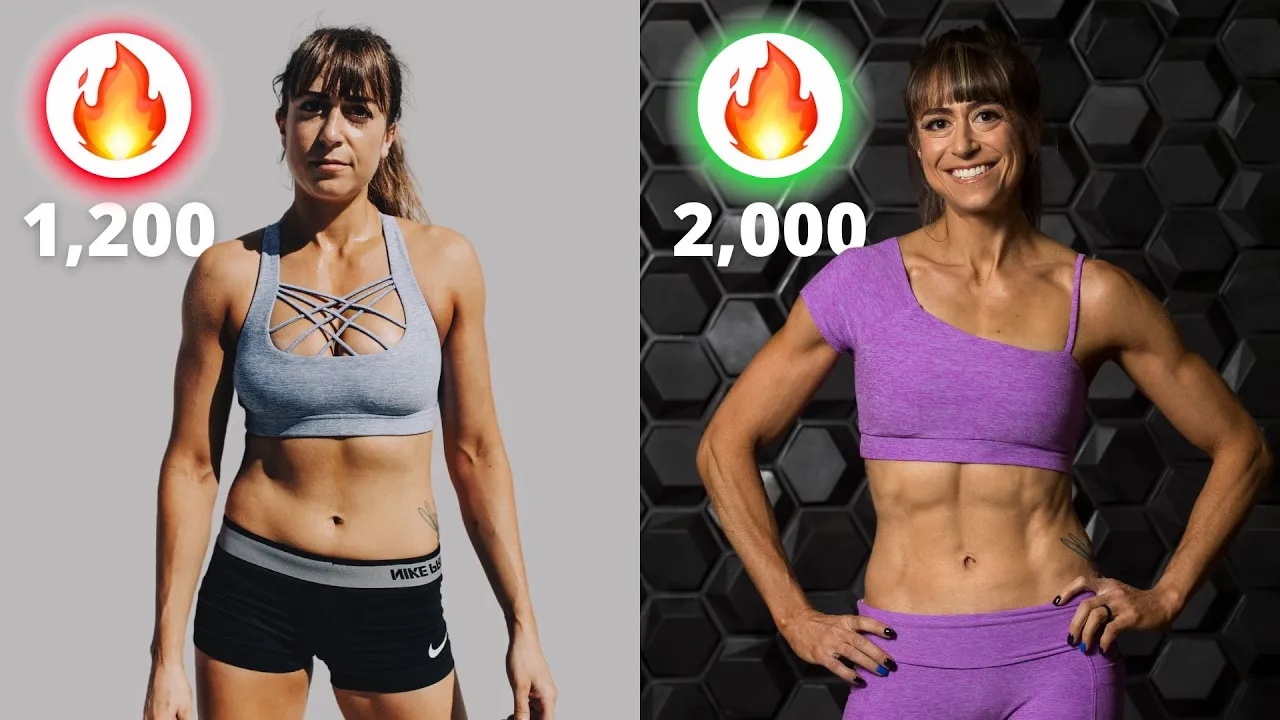Our metabolism does slow down as we get older.
But so much of the metabolic slowdown that we blame on age is actually due to lifestyle factors we can CHANGE adding up.
We have to remember that nothing works forever.
And often what we “got away with” even when we are younger is now coming back to haunt us.
As our body and lifestyle evolves, we’ve got to adjust how we fuel and train.
That’s why I’m going to share 6 tips to help boost your metabolism to lose fat at any and every age.

First, Focus On Hydration.
Many of us know we should drink more water.
But the struggle is real to actually change this habit.
Not only is it confusing to know how much water to drink but it’s hard to stop yourself during the day to get water when it isn’t already a part of your routine or you’re not really thirsty for it.
However, proper hydration becomes more important as we get older and even start the hormonal changes of perimenopause.
Especially if you’re training hard, you want to consider consuming MORE than the general recommendation of 50% of your bodyweight in ounces.
You want to even shoot for 70% of your bodyweight in ounces of water consumed every day.
While you may find setting out a filled water bottle by the coffee maker helpful to remind you to drink water even as you make your coffee, you can also improve your hydration levels by consuming more high water content foods over the course of the day.
To help you hit this amount and stay hydrated, don’t just only focus on drinking more water, as key as that is.
Make a salad of cucumbers, bell peppers, tomatoes and lettuce – all high water content foods.
Add berries to your oatmeal for breakfast to improve your hydration to start your day.
Or try melons in your cottage cheese as a protein rich snack to stay hydrated.
But focus not only on ways to drink more water but even improve your hydration through fruits and vegetables that also pack in the micronutrients to your diet as well!
Second, Eat 30-40 Grams Of Protein Per Meal.
Increasing your protein is key.
And while most of us have heard we can only consume 20-30 grams of protein at one sitting, this just isn’t the case.
While 20-30 grams may be the max we need to specifically utilize to build muscle from one sitting, this is also based on studies of protein supplements.
The other macros consumed at a meal will impact the rate of digestion, slowing the process even to better let us utilize more at a time.
Not to mention as we get older, we are less able to utilize protein as efficiently, meaning we need more to see the same results.
That’s why increasing our intake to 30-40 grams per meal, especially in our post workout meal can be super beneficial.
The harder you train, the more you want to focus on a higher protein intake to make sure you’re able to repair and recover more efficiently from your training.
If we aren’t able to recover and rebuild properly, we may see our hard work in the gym not pay off the way we’d like in terms of strength gains and muscle growth, which can impact our metabolic health.
And protein is not only key because of its muscle building benefits but also because it keeps us feeling fuller if we are in a calorie deficit to lose weight.
This can make sticking to our nutritional plan easier long-term which allows consistency and time to work their results magic.
Plus, protein has a higher thermic effect than the other macros, meaning your body burns more calories to digest and utilize it for other bodily functions and to keep the tissues of your body strong and healthy.
It’s also important to find your food quality balance.
I’m a big believer in working in the foods you love.
I love having a rice krispie treat or Reese peanut butter cup or ice cream as dessert.
And I will plan these things in first when I want them.
I also think we too often sabotage ourselves with this clean eating pressure where we feel we can’t have things we enjoy and eliminate foods arbitrarily that aren’t even necessarily an intolerance we personally struggle with.
BUT we do need to find a balance.
Quality fuel helps our body function best. And we always want to seek to balance enjoying life and functioning optimally!
We need those essential micronutrients to not only feel our best and stay healthy, but even to keep our metabolic rate higher and help us lose fat.
A few micronutrients you may want to focus on more if you are working to lose fat and rev that metabolism are choline, magnesium, vitamin D, selenium and zinc.
Choline is involved in the process of lipolysis, or fat loss, helping to break down fat into smaller pieces to be burned as energy.
Eggs, beef, red potatoes and kidney beans are all great sources to include.
Magnesium is involved in nearly everything, but when it comes to fat loss and metabolism, it helps control insulin and glucose, which both impact fat storage.
It also can help with water retention and bloating, especially as you are increasing protein and making other dietary changes.
Pumpkins, chia seeds, almonds and spinach are all great sources of magnesium.
Vitamin D is also key to include although harder to boost through our food consumption.
Even if we try to get out in the sun daily, as we get older we want to make sure we are boosting our intake even with a supplement.
Studies have shown that low levels of vitamin D are linked to higher rates of overweight and obesity.
And both selenium and zinc are key for proper thyroid functioning. Impaired thyroid function will lead to a slower metabolic rate.
To increase your intake of selenium include foods like brazil nuts, yellowfin tuna and halibut and to increase zinc consider oysters, pumpkin seeds, pork loin or even oats.
While I’ve talked about 3 key nutritional tips, the best results happen when our diet and our workouts work together.
That’s why you can’t ignore the importance of your training for your metabolic health.
When designing your workouts, stop just doing body part splits.
(Looking for workouts designed strategically to help you reach your goals? Check out my Dynamic Strength App!)
Design progressions that Work Your Upper And Lower Body In The Same Workout.
Full-body workouts or anterior/posterior splits can be beneficial if you are looking to keep your metabolism healthy as you get older without having to spend hours in the gym 6 days a week.
Not only are these workouts more efficient, but you will target multiple big muscle groups each and every workout to more effectively build muscle while also burning more calories per session.
While I never like to focus on training as just a time to burn more calories, this extra calorie burn because you’re working more big muscles per session to build more muscle isn’t a bad added bonus!
And by doing these splits, you can also increase your training frequency for each area over the week.
Training a body part 2-3 times per week over simply doing more for an area in a single session may help you see better muscle gains.
That training frequency for especially hard to grow areas of 2-3 times per week has shown to yield the best results.
It can also help you train the area at a higher intensity each session, performing a higher overall quality of work, as too often we simply include more training volume in a workout that becomes wasted as we fatigue over the session.
So consider designing workouts that allow you to target different areas every workout while hitting both big muscle groups in your upper and lower body each session!
The next training tip is to Focus On Low Reps And Heavy Weights.
Too often we turn to more cardio or metabolic workouts when we want to lose fat. They make us feel out of breath and like we worked hard.
But muscle is what stokes that metabolic fire.
To build that muscle we need heavy loads and progression in movements that challenges our muscles to tear them down so they have to rebuild stronger.
This is why you want to work down in reps and up in weights during your training.
And while using a diversity of rep ranges is ideal, do not ignore that maximal strength rep range of 1-5 reps even if muscle hypertrophy and fat loss is your goal.
Increasing our strength allows us to then move more weight overall during our training, resulting in better muscle gains.
So while you may have heard that 6-12 reps is best for muscle hypertrophy and you do want to include this rep range, working lower in reps with even heavier loads will ultimately make you stronger to lift more for those exercises done in the 6-12 rep range.
Consider including a single heavy compound lift at the start of your workout for 4-5 rounds of 3-5 reps, resting 3-5 minutes between rounds.
Follow that up with other compound accessory exercises in the 6-12 rep range to target specific muscle groups you’ve already started fatiguing with that first lift!
The final tip is to Sprint More.
That high intensity interval work is so key to our conditioning and metabolic health. It is a great way to burn calories in an efficient way as well.
And if you perform short intervals of work of even just 10-20 seconds with 3-5 times the rest, you can really train speed.
Just don’t get caught up on doing a bazillion rounds.
You don’t want to feel beat down from these short sessions. Less is more. Think even just 8-10 rounds of sprints.
Go all out and fully recover. You want to train speed which means not doing a work interval again until you’ve recovered.
When you include sprints in this way, not only can you help keep your metabolic rate higher, even increasing your calorie burn after the sessions, but you’ll help improve your mind-body connection to even get more out of your lifting.
This explosive power work helps you more efficiently recruit muscles which can lead to better strength gains.
These short intense bursts also help us see better results from our other workouts because they improve our conditioning and therefore our ability to recover more quickly between rounds of work.
Better recovery means better quality of work during our training!
Using these 6 tips you can improve your metabolic health to lose fat at any and every age.
Just remember the best results happen when our diet and our workouts work together!



does all your advise apply to men as well as women?
While things specific to menopausal/perimenopausal hormone changes wouldn’t, yes most of the tips with metabolism and building and retaining lean muscle as we get older are essential for men too!
Hello😊
Losing body fat around waist and stomach. Know you can’t spot reduce but is there a way to enhance this. I know they say it is through diet and it is the last place to lose it so you have to be consistent during slight calorie deficit 300-500 calories making protein your main macro as it keeps you full
Thank you 😊
Here are some tips to help – https://redefiningstrength.com/how-to-lose-stubborn-fat-3-tips/
I think fish is a GREAT protein source, yet can’t eat it every day because of mercury poisoning. What are your thoughts regarding the CDC’s guidelines of fish consumption?
There are now lots of options with very well tested fish and lots of seafood options even too that are very safe 🙂